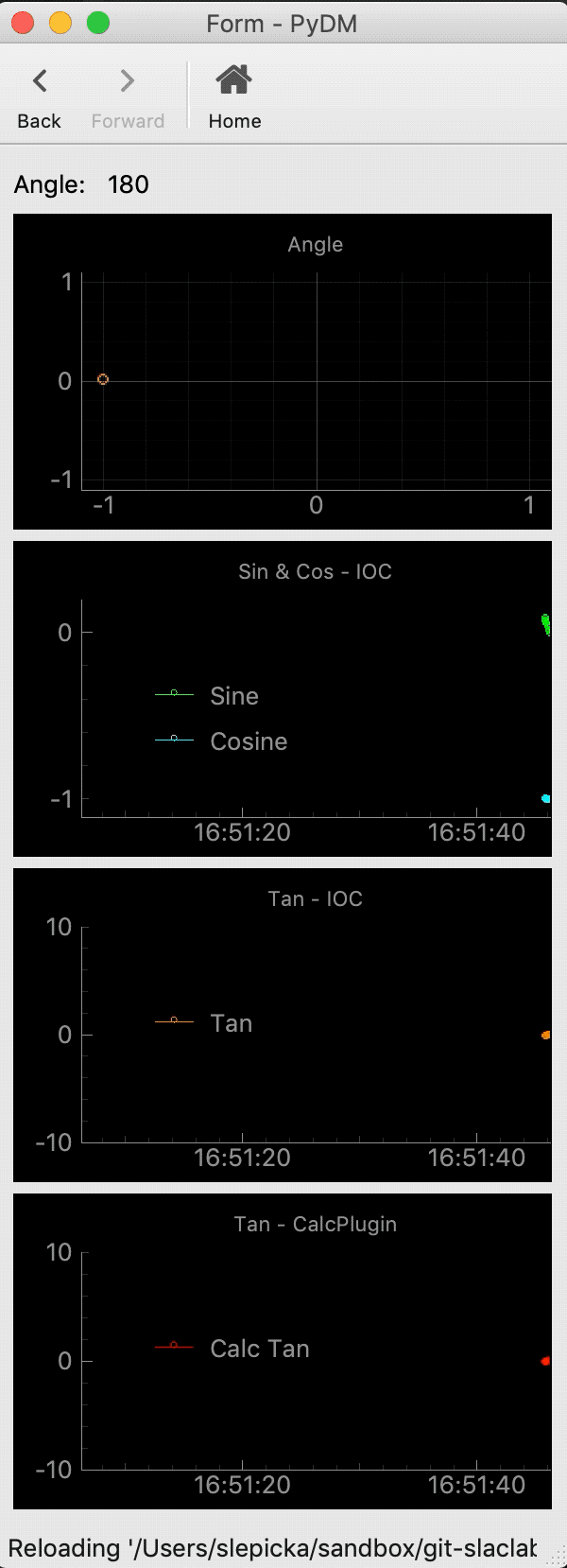Calc Plugin
PyDM uses Data Plugins as sources of information to be displayed at the widgets. Calc Plugin allows users to create and use mathematical expressions.
The Calc Plugin takes in data from given channels and then applies a mathematical expression, the result is broadcast to all the listeners connected to this particular calc channel.
By default, as soon as any widgets gets connected to the same channel variable, they will get the results from the mathematical expression defined in the channel’s address. These widgets can receive any updates when the calc channel’s output changes. For example, if the user has added a calc channel to a PyDMLabel, then the PyDMLabel will update whenever a new value from one of the channels listed by the calc plugin is pushed to the calc plugin.
General Calc Plugin channel syntax:
calc://my_variable_name?expr_var_name=channel://address&expr_var_name_two=channel://address&expr=math expression
Note
Once a calc channel is created, multiple widgets can be connected to the same channel by providing the name of the variable, like so:
calc://my_variable_name
Note
The calc functions uses url formatting. Where the name attribute is separated by the ? symbol and all other attributes are separated by the & symbol.
Required Attributes
In order to be able to properly create a calc channel, all the required attributes must be provided in the channel’s address.
The table below explains the attributes that are required to create a local plugin channel:
Attributes |
Description |
Format Example |
|---|---|---|
calc |
protocol name for Calc Plugin |
calc:// |
name |
the identifier for the mathematical expression
user’s choice
|
my_expr_name |
var |
variable mapped to an address for the expr
attribute.
|
var=channel://address |
expr |
mathematical expression
|
expr=math expression |
Here is a simple example of a channel address format with the required attributes:
calc://circ?var=ca://DEMO:ANGLE&expr=math.sin(math.radians(var))
Extra Attributes
Along with the required attributes, the Local Data Plugin can also accept some optional attributes to configure the Local Variables with. These attributes should be provided in the “extras” dictionary. The optional attributes are described in the extra attributes table below:
The table below explains the optional attributes that can go in the extras:
Attributes |
Description Type |
Format Example |
|---|---|---|
update |
The calc function will update when one of the
variables in the update list receives a new
value optional. If nothing is given, the calc
function will run anytime one of the variables
updates.
|
update=var, var_two |
Note
The “extras” Attributes are all optional, any number of desired attributes can be specified, or none.
Here is a simple example of a channel address format with some optional attributes:
calc://circ?var=ca://DEMO:ANGLE&var_two=loc://int_var&expr=var_two*var&update=var_two
Built-in Calc Helpers
Certain helper functions are built in to PyDM because they get semi-frequent use in the context of EPICS values.
Helpers |
Description |
Usage Example |
|---|---|---|
epics_string |
Convert a char waveform to a string. |
calc://my_string?var=ca://WAVEFORM:PV&expr=epics_string(var) |
epics_unsigned |
Force a signed integer to be unsigned. |
calc://my_int?var=ca://SOME:16BIT:INT&expr=epics_unsigned(var, 16) |
You should use epics_string when you have a string PV that is expressed as a char waveform, but you need to use the corresponding string value internally.
You should use epics_unsigned when you are dealing with a PV that is supposed to be interpreted as a positive integer but is instead a negative integer because channel access does not support any unsigned types and we have overflowed to negative values.
Simple Calc Plugin Example
The picture below represents an example of using the Calc Plugin. Calc addresses given in the channels of the Wavefrom Curve Editor of a PYDMWavefromPlot:
calc://circleX?angle=ca://DEMO:ANGLE&expr=-1*math.cos(math.radians(180-angle))
calc://circley?angle=ca://DEMO:ANGLE&expr=math.sin(math.radians(180-angle))
Calc address given in the channels of the Wavefrom Curve Editor of a PYDMWavefromPlot to get the Tangent:
calc://tanval?angle=ca://DEMO:ANGLE&expr=tan(radians(angle)) if angle not in [90, 270] else None
Values for TAN

Miscellaneous
See https://docs.python.org/3/library/math.html for mathematical operations which can be used in the given expression.
NumPy is a valid library for the mathematical expression and can be accessed via ‘numpy.xyz’ or ‘np.xyz’.
Already established local variables can be used in a calc variable attribute, but it is not possible to create a local plugin variable inside a calc variable attribute.
The calc plugin is intended to be only one level deep and will break if a calc channel is set as a variable of another calc channel.